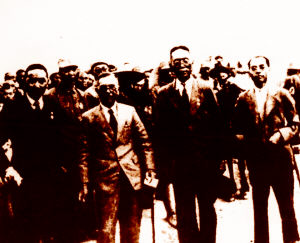Q: What did overseas Chinese do to assist China's war of resistance?
A: At the time of the war of resistance, there were close to eight million Chinese living overseas. Driven by a deep love of their homeland, these members of the Chinese nation made major contributions to assist China's war of resistance.

1. Resistance movements organized by Chinese communities overseas
Following the September 18th Incident (also known as the Mukden Incident), overseas Chinese vehemently protested the invasion of China by Japan, supported the resistance of the volunteer units in northeast China, and called on the rest of the world to safeguard peace and justice and put a stop to Japanese aggression.
During the War of Resistance, in addition to the three major organizations – the Federation of Overseas Chinese in Europe for Resistance founded in September 1936, the Relief Committee of Nanyang Overseas Chinese for China's Refugees established in October 1938, and the Chinese American Resistance Association founded in September 1943 – all kinds of overseas Chinese groups were established. In total there were over 3,940 such organizations. These organizations brought overseas Chinese together to support the resistance, and got them involved in activities to promote resistance efforts by publishing resistance-related newspapers and periodicals, establishing literary and art troupes, and creating literary works about the war of resistance.
Most Chinese people living in Southeast Asia were owners of small or medium-sized businesses. They took the lead in boycotting Japanese goods, and received a positive response from their local friends and counterparts. Many Chinese people working at Japanese iron mines in the region went on strike, causing a signi?cant decline in production, and even the complete paralysis of some mines.
In order to limit Japan's import of materials of strategic value from the US, on several occasions, Chinese people living in the US stood up to prevent the transport of waste iron to Japan, and managed to win the support of different sectors of American society.
2. Economic assistance
Overseas Chinese around the world found a variety of ways to make donations to support the war of resistance. To mark the anniversary of the Lugou Bridge Incident, in 1942, within a week Chinese people in New York had donated 900,000 yuan inChina's national currency. Those in Boston donated 1.5 million yuan, and the Counter-Japanese Assistance Society under the Chinese Consolidated Benevolent Association of New England donated 1.05 million yuan.
Donations came from overseas Chinese from all kinds of social backgrounds. From the leaders of overseas Chinese communities and well-known business magnates to people running small and medium-sized businesses, from prominent cultural ?gures to ordinary members of society, from senior citizens to elementary and high school students, people were eager to give whatever they could.
Many overseas Chinese also returned to China to make investments. The investments they made in China during the war were mainly in industry, mining, land reclamation and farming, and ?nance, and totaled between 1.8 billion and 1.9 billion yuan.
In addition to ?nancial aid, overseas Chinese also provided material support for China's war of resistance. Between 1937 and 1942, they donated a total of 217 airplanes. To a Chinese air force that was at that time rather weak, this was by no means an insigni?cant donation. Members of the overseas Chinese community also donated everything from trucks, ambulances, and medicines, including tablets for treating malaria patients, to mosquito nets, woolen blankets, cotton-wadded clothing, and other textile goods, and rice. There were even blood drives to support China in the resistance. Many overseas Chinese gave their own porcelain, paintings, calligraphy works, and antiques, as well as wedding rings, jewels, and other valuables to China to support the war effort.
Since the Revolution of 1911, donations had been a common way by which overseas Chinese had made contributions to China. Yet the scale of donations, the breadth of their coverage, the range of types of items donated, the signi?cance of the role they played, and the touching stories behind these donations were unprecedented before the war of resistance.
3. Contributions of manpower
Following Japan's launch of a full-scale war of aggression against China, most of the transport routes by both land and water linking China to the outside world were cut off. In the Southwest, the only route was the Burma Road, which had been built hastily and in treacherous conditions owing to the winding mountains and wild rapids it negotiated. Altogether there were 3,913 overseas Chinese drivers and mechanics from Southeast Asia recruited to work back in China, with the majority working on the Burma Road and the rest scattered around other parts of the country. In just over three years while they were working along the road, Chinese drivers and mechanics from Southeast Asia transported 450,000 metric tons of combat supplies and more than 1,000 of these people gave their lives while working on the road.
After the War of Resistance went nationwide, Chinese Americans began to found aviation schools and societies in the hope that China could be protected through the development of its aviation industry. Two of these aviation schools – the Al Greenwood Flying School in Portland and another school in San Francisco – sent as many as 110 outstanding young pilots back to China to take part in the resistance efforts.
Organizing first-aid teams, and various other service groups, such as those formed to show solicitude for the soldiers, was an important way by which overseas Chinese contributed their own time and energy for the country's cause. In March 1940, the 67-year-old Tan KahKee led a consolation and inspection team of over 40 members from the Relief Committee of Nanyang Overseas Chinese for China's Refugees and presented the government with 3.2 million yuan as a way of demonstrating their solicitude for the country.